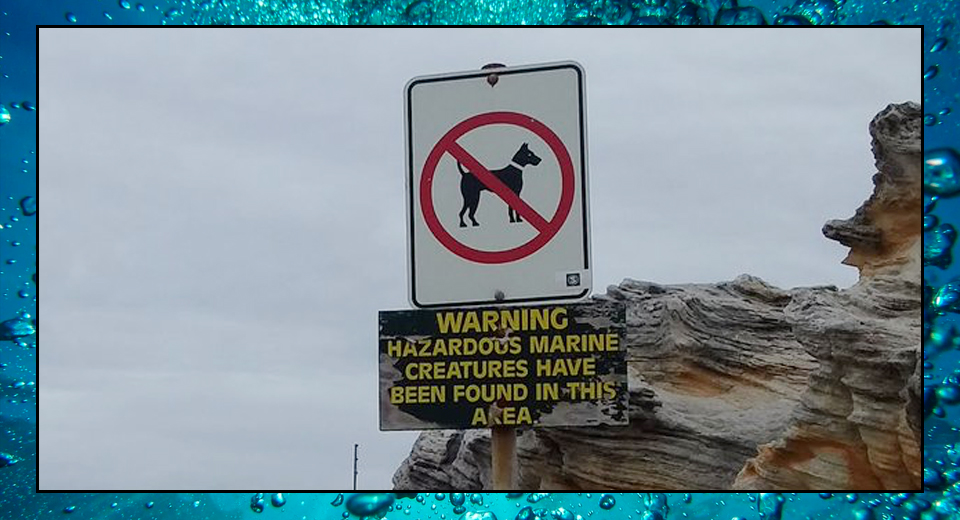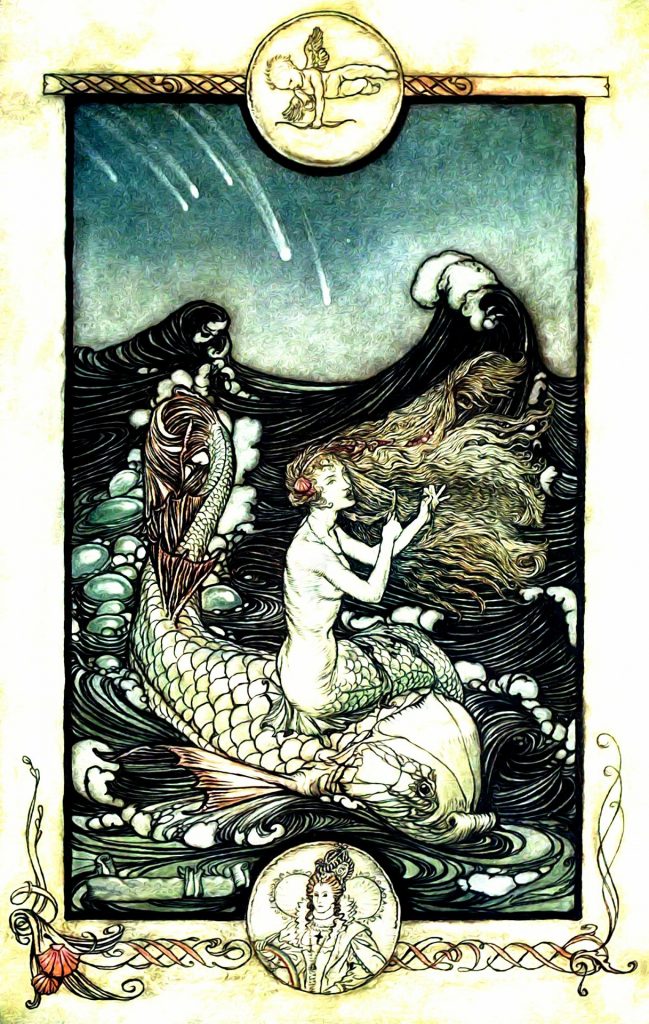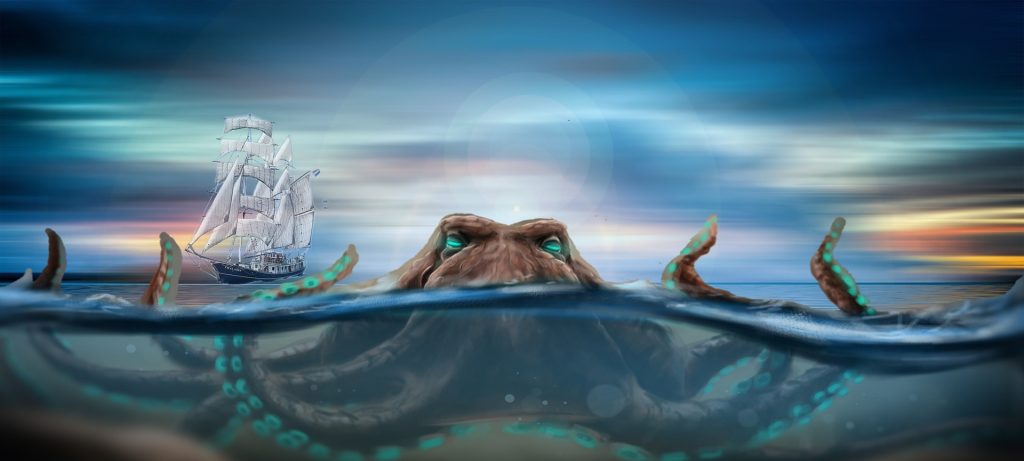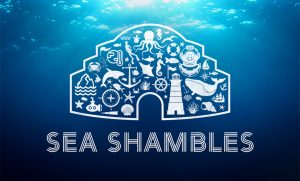Sea Monsters
Sea Shambles Advent Calendar - December 7thDecember 7th
With a warning of hazardous marine creatures, we turn to the horror and monster expert in our midst, Robin Ince.

When I got married I became attached to two family legends.
One was that my wife was related to music hall legend Little Tich, the other was that the north eastern arm of the family had caught a mermaid. Sadly, there is no bloodline to Little Tich. Somewhere in those unreliable narrator Christmas family parties, a visit to Sunderland Empire had confused top of the bill with top of the family tree. The mermaid is more likely. Eventually sold to a hair salon in North Shields, somehow a pickled fish’s tail and an embalmed monkey’s head had become a member of the clan.
When did such legends of the sea lose their authenticity? Who was the last sailor to have been aroused by a sea cow distant enough that his briny eyes could have confused it for an ichthyic Diana Dors? Now that the Earth is flat again, how soon before such mythical creatures are real for some again.

Richard Feynman wrote of how the imagination of nature is far greater than the imagination of humans. What we see in the sea confirms that. The ocean is filled with strange flamboyance and peculiar grotesques, though I should be clear that these are subjective grotesques, my human judgement of beauty is very human centred. The Blob Fish has become the face of The Ugly Animal Appreciation Society. It is greatly helped by one particular photograph that makes it almost impossible not to anthropomorphise. The sea squirt is a creature whose brain is only temporarily required. Once it has used its brain to find a secure place to stay, it eats its brain. I fear something similar has happened to those who have found a sofa comfy enough to tweet from for the rest of their life. The Red-lipped Batfish and Piglet Squid are further marine delights, so strange and wonderful that it is best to remain sceptical of their existence until their reality has been confirmed by at least three trustworthy marine biologists.
With such creatures being real, it is not surprising that the sea became a place that was further populated by creatures from the human imagination. Being reared in the time of Arthur C Clarke’s Mysterious World and The Unexplained magazine, I was a child ready to believe in oceanic monstrosities, as well as spontaneous combustion, Kirlian photography, ESP and UFOs, lots and lots of UFOs. Sea monsters first cropped up in Issue 5 of The Unexplained.
The Cosmic Shambles Network relies on your support on pledges via Patreon so we can continue to provide great, new, exciting content without the need for third party ads or paywalls.
For as little as $1 a month you can support what we do and get some great rewards for doing so as well. Click the Patreon logo to pledge or find out more.
“Even today, marine biologists, who have long been aware of the vast unexplored depths of the Earth’s oceans, cautiously accept that the numerous reports of sea monster sightings seem to provide evidence that many creatures, at present unknown and unclassified, may be living in the dark and hidden waters,” wrote Janet and Colin Bord forty years ago. The oceans remain almost 80% mysterious despite our exploring. We know more about the moon than about our oceans, lifeless spheres are easier (apologies to any Selenites).

There is still something both thrilling and disconcerting when looking at paintings of enormous Krakens engulfing ships or fanged sea serpents nibbling the skulls of sailors. The Kraken was most likely a giant squid, something still remarkable without the horror story narrative. Decay has added to enigmas. The remnants of sea creatures can take on new forms, a wretched and rotten carcass Rorschach test for those keen to build new monsters. The remnants of a rare beaked whale washed up on a beach near Santa Cruz became dinosaurian to look at. The rediscovery of Coelacanths in 1937 offered a vague hope that maybe Plesiosaurs could be lurking not far behind. And what of the octopus? A creature so smart that ardent carnivore Professor Brian Cox has taken it off his menu after an undersea flirtation. The octopus look enhances many any illustration of HP Lovecraft’s Cthulhu clan.
As usual, the narrative of the real sea monster may be our destruction of so much marine life, but I will leave that to others better qualified to discuss at next year’s Sea Shambles, I’ll return to my painting of a Devil Fish consuming the onboard entertainment of a luxury cruise liner as Richard Dreyfuss looks on in horror.
This picture was contributed on Twitter by @EdwinQuail
 Sea Shambles is a one night only live extravaganza celebrating the oceans. Hosted by Robin Ince and Helen Czerski with Steve Backshall, British Sea Power, Josie Long, Lemn Sissay and more it’s a night of science, comedy, music, lasers and more in which we’ll be turning the Royal Albert Hall into an underwater playground the likes of which you’ve never seen! May 17 2020. Tickets start at just £10! Book here.
Sea Shambles is a one night only live extravaganza celebrating the oceans. Hosted by Robin Ince and Helen Czerski with Steve Backshall, British Sea Power, Josie Long, Lemn Sissay and more it’s a night of science, comedy, music, lasers and more in which we’ll be turning the Royal Albert Hall into an underwater playground the likes of which you’ve never seen! May 17 2020. Tickets start at just £10! Book here.
 Robin Ince is a multi-award winning comedian, writer and broadcaster. As well as spending decades as one the UK’s most respected stand-ups, Robin is perhaps best known for co-hosting The Infinite Monkey Cage radio show with Brian Cox. For his work on projects like Cosmic Shambles he was made an Honorary Doctor of Science by Royal Holloway, University of London.
Robin Ince is a multi-award winning comedian, writer and broadcaster. As well as spending decades as one the UK’s most respected stand-ups, Robin is perhaps best known for co-hosting The Infinite Monkey Cage radio show with Brian Cox. For his work on projects like Cosmic Shambles he was made an Honorary Doctor of Science by Royal Holloway, University of London.
If you would like to reuse this content please contact us for details
Subscribe to The Cosmic Shambles Network Mailing list here.
The Cosmic Shambles Network relies on your support on pledges via Patreon so we can continue to provide great, new, exciting content without the need for third party ads or paywalls.
For as little as $1 a month you can support what we do and get some great rewards for doing so as well. Click the Patreon logo to pledge or find out more.


